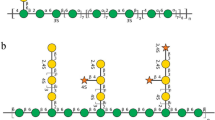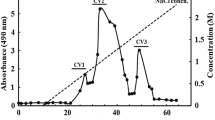Abstract
Two relatively pure polysaccharides H3-a1 and H3-b1 had been isolated from the brown seaweed Hydroclathrus clathratus. They were characterized by HPLC, ultraviolet scanning, gas chromatography, infrared spectroscopy and elemental analysis, and shown to be two different sulfated polysaccharides with different monosaccharide content, but both with high relative molecular mass. They contained some proteins and uronic acid respectively. The sulfate content and bioactivity of these polysaccharides varied during purification. The fractions derived from the hot water extract also exhibited low anticoagulant effect. This is the first time that the antiherpetic and anticoagulant activities were evaluated for the polysaccharides from the Hong Kong brown seaweed Hydroclathrus clathratus.
Similar content being viewed by others
References
Witvrouw M, De Clercq E. Sulfated plysaccharides etracted from sea algae as potential antiviral drugs. Gen Phamacol, 1997, 29: 497–511
Ponce N M A, Pujol C A, Damonte E B, et al. Fucoidans from the brown seaweed Adenocystis utricularis: Extraction methods, antiviral activity and structural studies. Carbohydr Res, 2003, 338: 153–165
Carlucci M J, Scolaro L A, Errea M I, et al. Antiviral activity of natural sulphated galactans on herpes virus multiplication in cell culture. Planta Med, 1997, 63: 429–432
Lee J B, Hayashi K, Hayashi T, et al. Antiviral activities against HSV-1, HCMV, and HIV-1 of Rhamnan sulfate from Monostroma latissimum. Planta Med, 1999, 65: 439–441
Riou D, Colliec-Jouault S, Du Sel D P, et al. Antitumor and antiproliferative effects of a fucan extracted from Ascophyllum nodosum against a non-small-cell bronchopulmonary carcinoma line. Anticancer Res, 1996, 16: 1213–1218
Albuquerque I R L, Queiroz K C S, Alves L G, et al. Heterofucans from Dictyota menstrualis have anticoagulant activity. J Med Biol Res, 2004, 37: 167–171
Zhang Q B, Li N, Liu X G, et al. The structure of a sulfated galactan from Porphyra haitanensis and its in vivo antioxidant activity. Carbohydr Res, 2004, 339: 105–111
Blondin C, Fischer E, Boisson-Vidal C, et al. Inhibition of complement activation by natural sulfated polysaccharides (fucans) from brown seaweed. Mol Immunol, 1994, 31: 247–253
Dubois M, Gilles K A, Hamilton J K, et al. Colorimetric method for determination of sugars and related substances. Anal Chem, 1956, 28: 350–356
Harris E L V, Angal S. Protein Purification Methods: A Practical Approach. Oxford, New York: IRL Press, 1989. 11–12
Li Y L, But P P H, Ooi V E C. Antiviral activity and mode of action of caffeoylquinic acids from Schefflera heptaphylla (L.) Frodin. Antiviral Res, 2005, 68: 1–9
Carlucci M J, Scolaro L A, Damonte E B. Herpes simplex virus type 1 variants arising after selection with an antiviral carrageenan: Lack of correlation between drug susceptibility and syn phenotype. J Med Virol, 2002, 68: 92–98
Matsuhiro B, Zúñiga E, Jashes M, et al. Sulfated polysaccharides from Durvillaea Antarctica. Hydrobiologia, 1996, 321: 77–81
Blakeney A B, Harris P J, Henry R J, et al. A simple and rapid preparation of alditol acetates for monosaccharide analysis. Carbohydr Res, 1983, 113: 291–299
Craigie J S, Wen Z C, Van der Meer J P. Interspecific, intraspecific and nutritionally-determined variations in the composition of agars from Gracilaria spp. Bot Mar, 1984: 27: 55–61
Guezennec J G, Pignet R, Raguenes G, et al. Preliminary chemical characterization of unusual eubacterial exopolysaccharides of deep-sea origin. Carbohydr Polymers, 1994, 24: 287–294
Franz G. Polysaccharides in pharmacy: Current applications and future concepts. Planta Medica, 1989, 55: 493–497
Pereira M S, Mulloy B, Mourão P A S. Structure and anticoagulant activity of sulfated fucans. J Biol Chem, 1999, 274: 7656–7667
Béress A., Wassermann O, Bruhn T, et al. A new procedure for the isolation of anti-HIV compounds (polysaccharides and polyphenols) from the marine alga Fucus vesiculosus. J Nat Prod, 1993, 56:478–488
Melo F R, Pereira M S, Fogue D, et al. Antithrombin-mediated anticoagulant activity of sulfated polysaccharides. J Biol Chem, 2004, 279: 20824–20835
Berteau O, Mulloy B. Sulfated fucans, fresh perspectives: structures, functions, and biological properties of sulfated fucans and an overview of enzymes active toward this class of polysaccharide. Glycobiology, 2003, 13: 29R–40R.
Chun H, Shin D H., Hong B S, et al. Purification and biological activity of acidic polysaccharide from leaves of Thymus vulgaris L. Biol Pharm Bull, 2001, 24: 941–946
Rupérez P, Ahrazem O, Leal J A. Potential antioxidant capacity of sulfated polysaccharides from the edible marine brown seaweed Fucus vesiculosus. J Agric Food Chem, 2002, 50: 840–845
Nishino T, Nishioka C, Ura H.. Isolation and partial characterization of a novel amino sugar-containing fucan sulfate from commercial Fucus vesiculosus fucoidan. Carbohydr Res, 1994, 255: 213–224
Laquerre S, Argnani R, Anderson D B, et al. Heparan sulfate proteoglycan binding by herpes simplex virus type 1 glycoproteins B and C, which differ in their contributions to virus attachment, penetration, and cell-to-cell spread. J Virol, 1998, 72: 6119–6130
Yim J H, Kim S J, Ahn S H, et al. Antiviral effects of sulfated exopolysaccharide from the marine microalga Gyrodinium impudicum strain KG03. Mar Biotechnol, 2004, 6: 17–25
Patankar M S, Oehninger S, Barnett T, et al. A revised structure for fucoidan may explain some of its biological activities. J Biol Chem, 1993, 268: 21770–21776
Author information
Authors and Affiliations
Corresponding author
Additional information
Supported by the Research Grants Council of the Hong Kong Special Administrative Region, China (Project No. CUHK4367/01M) and a Direct Grant from the Chinese University of Hong Kong
Rights and permissions
About this article
Cite this article
Wang, H., Ooi, E.V. & Ang, P.O. Antiviral polysaccharides isolated from Hong Kong brown seaweed Hydroclathrus clathratus . SCI CHINA SER C 50, 611–618 (2007). https://doi.org/10.1007/s11427-007-0086-1
Received:
Accepted:
Issue Date:
DOI: https://doi.org/10.1007/s11427-007-0086-1




